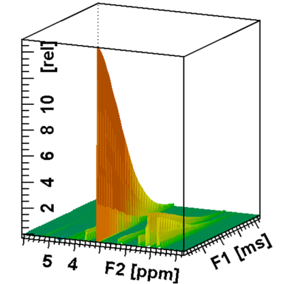diffusion coefficient is a crucial parameter used to quantify the rate of diffusion of a substance in a given medium. It is commonly used in various scientific fields, including physics, chemistry, and biology, to understand the movement and spread of particles or molecules. In this blog post, we will explore how to calculate diffusion coefficient, including different formulas, mathematical expressions, and experimental techniques.
How to Calculate Diffusion Coefficient


A. Overview of the Calculation Process
Calculating the diffusion coefficient involves determining the rate at which particles or molecules disperse in a medium over time. It provides insights into the behavior of substances in different conditions and helps analyze their transport properties. To calculate the diffusion coefficient, we need to consider factors such as time, displacement, and the properties of the medium.
B. Diffusion Coefficient Formula and its Components
The diffusion coefficient is obtained by dividing the mean square displacement ![]() of the particles by the time elapsed. The formula for calculating the diffusion coefficient is as follows:
of the particles by the time elapsed. The formula for calculating the diffusion coefficient is as follows:
![]()
Where:
– ![]() represents the diffusion coefficient
represents the diffusion coefficient
– ![]() is the mean square displacement
is the mean square displacement
– ![]() is the time interval
is the time interval
The mean square displacement is calculated by measuring the average squared distance traveled by the particles over a given time period.
C. Step-by-step Guide to Calculate Diffusion Coefficient
To calculate the diffusion coefficient, follow these steps:
- Collect data: Record the positions of the particles at different time intervals.
- Calculate displacement: Determine the displacement of each particle from its initial position. The displacement is the difference between the final and initial positions.
- Square the displacement: Square the displacement of each particle.
- Find the average: Calculate the average of the squared displacements.
- Calculate the diffusion coefficient: Divide the average squared displacement by 6 times the time interval.
Let’s move on to exploring experimental methods of calculating the diffusion coefficient.
Calculating Diffusion Coefficient Experimentally

A. Preparation for the Experiment
Before conducting an experiment to calculate the diffusion coefficient, it is essential to set up the necessary apparatus and prepare the sample. The following steps can be followed:
- Select the medium: Choose an appropriate medium for the experiment, such as air, water, or a specific solution.
- Prepare the sample: Introduce the substance or particles into the medium in a controlled manner. This can be achieved through various methods, such as adding a drop of the substance into the medium or injecting it using a syringe.
- Set up the observation system: Arrange a suitable observation system to track the movement of the particles. This can be done using microscopy techniques or other tracking methods.
B. Conducting the Experiment
Once the preparation is complete, the actual experiment can be conducted. Here are the steps involved:
- Observe the particles: Start recording the positions of the particles at regular time intervals using the chosen observation system.
- Track the displacement: Determine the displacement of each particle from its initial position at each time interval.
- Calculate the mean square displacement: Square the displacement of each particle and calculate the average of the squared displacements.
- Measure the time interval: Note the time interval between each position measurement.
C. Analyzing the Results
After collecting the necessary data, it’s time to analyze the results and calculate the diffusion coefficient. Follow these steps:
- Find the average squared displacement: Calculate the average of the squared displacements obtained from the experiment.
- Determine the time interval: Note the time interval used in the experiment.
- Apply the diffusion coefficient formula: Use the formula (D = \frac{{\text{MSD}}}{6 \times t}) to calculate the diffusion coefficient, where (\text{MSD}) is the average squared displacement and (t) is the time interval.
By following these steps, you can experimentally calculate the diffusion coefficient of a substance in a given medium.
Calculating Specific Types of Diffusion Coefficients
A. How to Calculate Apparent Diffusion Coefficient
The apparent diffusion coefficient ![]() is a measure of how molecules or particles diffuse in a heterogeneous medium. It accounts for variations in the diffusion process due to differences in the medium’s properties. To calculate the ADC, follow a similar approach as for the diffusion coefficient, but consider the specific characteristics of the heterogeneous medium.
is a measure of how molecules or particles diffuse in a heterogeneous medium. It accounts for variations in the diffusion process due to differences in the medium’s properties. To calculate the ADC, follow a similar approach as for the diffusion coefficient, but consider the specific characteristics of the heterogeneous medium.
B. How to Calculate Effective Diffusion Coefficient
The effective diffusion coefficient takes into account the influence of external factors, such as temperature, pressure, and concentration, on the diffusion process. It represents the overall diffusion behavior under specific conditions. To calculate the effective diffusion coefficient, incorporate the relevant parameters into the diffusion coefficient formula.
C. How to Calculate Chloride Diffusion Coefficient
The chloride diffusion coefficient measures the rate at which chloride ions move through a substance, typically concrete. It is essential for understanding the durability of concrete structures. The calculation involves conducting experiments specifically designed to measure the movement of chloride ions and applying the diffusion coefficient formula.
D. How to Calculate Diffusion Coefficient of Protein
To calculate the diffusion coefficient of a protein, specialized techniques such as fluorescence correlation spectroscopy or dynamic light scattering are often employed. These methods allow for the measurement of protein dynamics and enable the determination of the diffusion coefficient based on the obtained data.
Calculating Diffusion Coefficient Using Different Software
Various software packages provide tools for calculating the diffusion coefficient based on simulation or experimental data. Let’s explore how to calculate the diffusion coefficient using some commonly used software:
A. How to Calculate Diffusion Coefficient in VMD
VMD ![]() is a powerful software used for visualizing and analyzing molecular dynamics simulations. It provides tools to calculate the diffusion coefficient of molecules in a simulated system. By analyzing the trajectory data and applying suitable algorithms, VMD can accurately determine the diffusion coefficient.
is a powerful software used for visualizing and analyzing molecular dynamics simulations. It provides tools to calculate the diffusion coefficient of molecules in a simulated system. By analyzing the trajectory data and applying suitable algorithms, VMD can accurately determine the diffusion coefficient.
B. How to Calculate Diffusion Coefficient in Matlab
Matlab, a popular programming language, is widely used for scientific computing and data analysis. It offers various functions and algorithms to calculate the diffusion coefficient from experimental data. By implementing the necessary calculations and analysis, Matlab can provide accurate results for different types of diffusion coefficients.
C. How to Calculate Diffusion Coefficient in Gromacs
Gromacs is a versatile molecular dynamics simulation software used for studying the behavior of molecules. It includes built-in tools for calculating the diffusion coefficient based on simulated trajectories. By utilizing Gromacs’ analysis capabilities, researchers can obtain reliable diffusion coefficient values for different systems.
Worked Out Examples
Let’s go through some worked-out examples to solidify our understanding of calculating diffusion coefficient:
A. Diffusion Coefficient Calculation Example
Suppose we have measured the mean square displacement of particles as 4.5 square units and the time interval as 2 seconds. To calculate the diffusion coefficient, we can use the formula ![]() . Substituting the values, we get:
. Substituting the values, we get:
![]()
Therefore, the diffusion coefficient in this example is 0.375 units per second.
B. How to Calculate Diffusion Coefficient from MSD
If we are given the mean square displacement ![]() of particles as 9 square units and the time interval as 3 seconds, we can calculate the diffusion coefficient by applying the formula
of particles as 9 square units and the time interval as 3 seconds, we can calculate the diffusion coefficient by applying the formula ![]() . Substituting the values, we get:
. Substituting the values, we get:
![]()
Hence, the diffusion coefficient in this case is 0.5 units per second.
C. Diffusion Coefficient from Velocity Autocorrelation Function
In some cases, the diffusion coefficient can also be obtained from the velocity autocorrelation function ![]() . By analyzing the temporal correlation of particle velocities, it is possible to calculate the diffusion coefficient using specific mathematical methods. However, the detailed explanation of this technique goes beyond the scope of this blog post.
. By analyzing the temporal correlation of particle velocities, it is possible to calculate the diffusion coefficient using specific mathematical methods. However, the detailed explanation of this technique goes beyond the scope of this blog post.
Common Mistakes and Misconceptions in Calculating Diffusion Coefficient
While calculating the diffusion coefficient, there are some common mistakes and misconceptions to be aware of. Some of them include:
- Neglecting the time interval: It is crucial to accurately measure and consider the time interval between position measurements to obtain reliable diffusion coefficient values.
- Incorrectly interpreting experimental data: Analyzing the results of experiments to calculate the diffusion coefficient requires attention to detail and proper understanding of the underlying principles.
- Overlooking temperature and pressure effects: External factors such as temperature and pressure can significantly impact the diffusion process. Neglecting their influence may lead to inaccurate diffusion coefficient calculations.
By avoiding these mistakes and misconceptions, researchers can ensure more accurate and meaningful diffusion coefficient calculations.
Through this comprehensive exploration, we have gained a solid understanding of how to calculate diffusion coefficient. We have covered the calculation process, experimental techniques, specific types of diffusion coefficients, software-based calculations, and examples. Remember, the diffusion coefficient serves as a valuable parameter for studying the behavior of particles and molecules in different systems, contributing to the advancement of numerous scientific fields.

I am Deepak Kumar Jani, Pursuing PhD in Mechanical- Renewable energy. I have five years of teaching and two-year research experience. My subject area of interest are thermal engineering, automobile engineering, Mechanical measurement, Engineering Drawing, Fluid mechanics etc. I have filed a patent on “Hybridization of green energy for power production”. I have published 17 research papers and two books.
I am glad to be part of Lambdageeks and would like to present some of my expertise in a simplistic way with the readers.
Apart from academics and research, I like wandering in nature, capturing nature and creating awareness about nature among people.
Also refer my You-tube Channel regarding “Invitation from Nature”